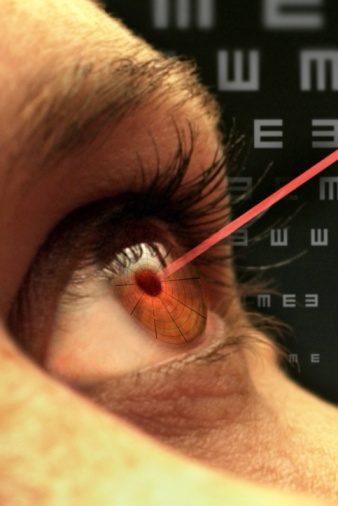

Laser eye surgery (also called LASIK) is a simple procedure whereby the shape of the cornea (a clear layer covering the eye) is corrected using a laser so that the light passing through it falls on the retina. Ophthalmology studies report that about 95 percent of patients are satisfied with their new vision.
Despite this fact, patients need to be aware of the possible side effects associated with LASIK. An estimated 6 million Americans underwent Laser eye surgery that permanently reshapes the cornea. There are no guarantees of 20/20 vision and the long-term safety of the procedure is still unknown. A small number of patients have reported permanent damage to their eyes following the surgery.
The US Food and Drug Administration (FDA) in the US published a report based on 140 complaints received by them between 2000 and 2009 related to long term side effects of laser eye surgery. For the majority of laser eye surgery patients, side effects are mild. Usually the side effects subside within the first 6 weeks or so after surgery. Some disappear in just days. Most side effects usually disappear in about 6 months.
Following are some of the most common side effects experienced after having laser eye surgery.
- Lack of crispness of vision is described as ‘loss of contrast sensitivity’. The loss of sharpness of the vision is most noticeable if the patient did wear gas permeable contact lenses before the surgery.
- Glare is experienced by many laser eye surgery patients which results in decreased night vision. This is usually a temporary condition, resolving in about 6 weeks.
- Eye infection could develop which will cause the healing process to take a lot longer but can be treated immediately.
- Halo Effect: During the evening when the light is dim patients may experience a halo effect that can last for around two weeks which is caused from an untreated peripheral cornea.
- Dry Eye: Some patients may experience dry eye after laser eye surgery which means the eye is unable to produce tears and causing burning sensation as well as irregular blurring. Dry eyes occur frequently in the population over 40 years of age whether laser eye surgery has occurred or not.
- Flap Loss: During the surgical procedure a flap of tissue is created over the cornea which should remain in place for at least twenty four hours post operatively. However this flap could be accidentally removed due to a patient rubbing or touching the eye within the stipulated time period and this in known as flap loss. In the event of flap loss the patients needs to inform the surgeon right away.
In some cases, patients need to wear corrective lenses even after having laser eye surgery due to under correction or overcorrection as not all patients respond same to the surgery.
Some patients with poor outcomes from LASIK surgery report a significantly reduced quality of life because of vision problems or physical pain associated with the surgery. Most experienced and reputable clinics tend to do a full-dilation medical eye exam prior to surgery and give adequate post-operative patient education care to minimize the risk of a negative outcome.
Just like every procedure, laser surgery can also prove to be a double edged sword if not handled with care. Prospective patients need to carefully weigh the risks and benefits of such a procedure based on personal value system as satisfaction is directly related to expectation. It is highly recommended to discuss all possible side effects with a surgeon before deciding to go ahead and have laser eye surgery done.